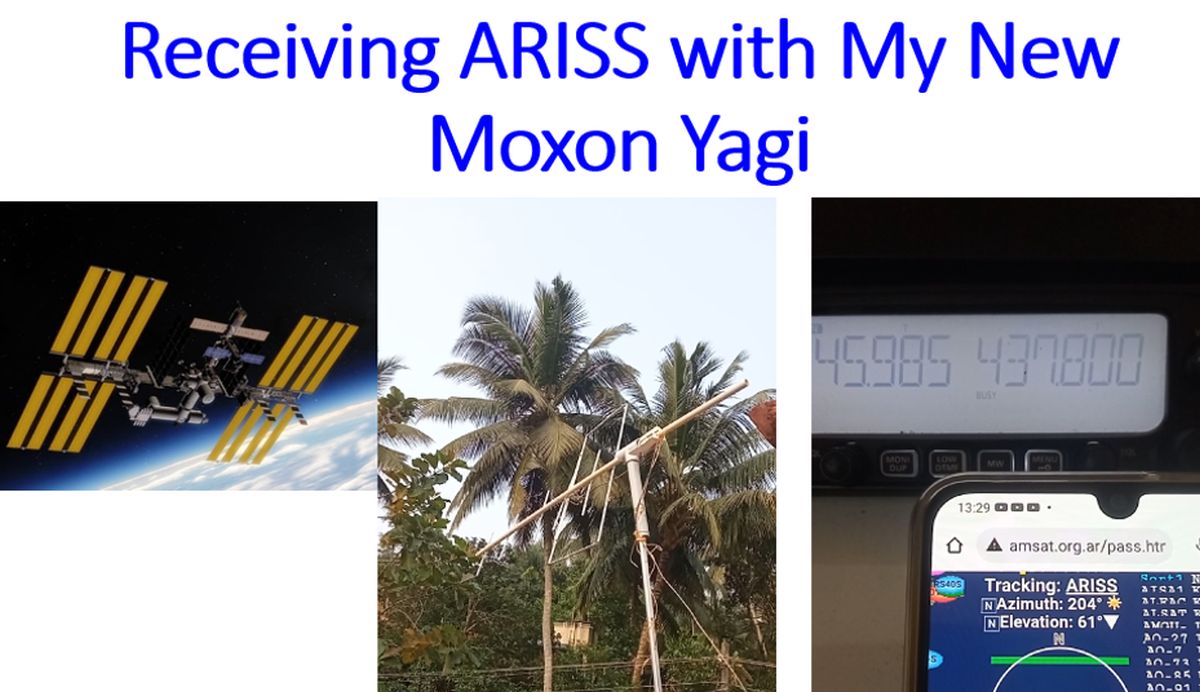Receiving ARISS (Amateur Radio on the International Space Station) with My New Moxon Yagi!
Receiving ARISS (Amateur Radio on the International Space Station) with My New Moxon Yagi!
What you heard just now is the reception of Amateur Radio on the International Space Station, known in short as ARISS, being received in my IC 2730 full duplex radio with my new Moxon Yagi. Recently I had built a Moxon Yagi for my LEO satellite work. It has a Moxon driven element and a Moxon reflector for VHF. The VHF driven element couples passively to the five UHF elements on the same boom, the advantage being that we need only one feedline and no diplexer is needed while operating with a single full duplex radio.
Interesting feature of this antenna is that there is no physical connection between the UHF elements and the feedline which takes the received signals to the radio! Boom was made of surplus PVC pipe used as conduit for electrical wiring. Elements were made of 3/8 inch aluminium pipes. My Moxon Yagi has been kept at a fixed Azmimuth and elevation on a short mast on my first floor terrace, at a height less than my second floor roof. It is a prototype which needs a bit more of aesthetic perfection. Mobile phone with Argentian Amasat website displayed for manual Doppler correction can also be seen.

I had kept the Moxon Yagi nearly towards the middle of the pass aiming at the azimuth of Maximum Elevation. It was a pass with about 65 degrees maximum elevation. Though I had planned a full pass recording, I could start only when the pass was already at 45 degrees up. I could hear stations well. The hissing noise which you hear in between the stations is the noise of the open squelch in my FM radio. You may notice that the noise disappears when the amateur radio station is heard well. I had started 5 kHz above the nominal frequency at 437.805 MHz, which was the Doppler correction displayed when I started the recording. Towards the time of closest approach you can see me tuning down to 437.800 MHz, which is the nominal downlink frequency of ARISS. As I was concentrating only on reception, I had left the uplink VFO as such and did not tune it up as usually done when tune the downlink VFO down. That is why you can see that the display is constantly at 145.985 MHz set at the beginning of the pass.
Towards the end of the recording you can see that the downlink frequency has been brought down to 437.790 MHz in intermittent steps of 5 kHz each, according to the Doppler correction displayed on the tracking website. No azimuth – elevation tracking was possible as I do not have an antenna rotator. Importance of Doppler correction is well displayed as you can hear stations better when the Doppler correction is made intermittently. Towards the down phase of the pass the signals were of poor quality as antenna orientation could not be corrected as per the direction of the satellite pass.
There could also be mismatch between the antenna orientation of the stations towards the satellite, polarization of antennas and Doppler correction. It is for these reasons that ideal way to work ARISS is using cross Yagi with circular polarisation for VHF and UHF, being rotated on azimuth and elevation by a computer program, which also does the Doppler correction in the radio. Amateur Radio on the International Space Station is receiving the signals from amateur radio operators on the ground within its range on VHF and transmitting the extracted audio down the downlink on UHF. So it is functioning as a cross band repeater.
I am happy that a good bit of the pass was workable with a fixed azimuth and elevation. Though I had planned to keep the Moxon Yagi at an elevation of about 15 degrees, it sagged down due to failure of strength of the ties used for keeping it elevated and in fact sagged a little below the horizontal at the time of reception!